
Intro to Digital Signal Processing
Collection edited by: Robert Nowak
Content authors: Robert Nowak, Don Johnson, Michael Haag, Behnaam Aazhang, Nick
Kingsbury, Benjamin Fite, Melissa Selik, Richard Baraniuk, Dan Calderon, Ivan Selesnick, Bill
Wilson, Hyeokho Choi, Douglas Jones, Swaroop Appadwedula, Matthew Berry, Mark Haun, Dima
Moussa, Daniel Sachs, Roy Ha, Justin Romberg, and Phil Schniter
Online: < http://cnx.org/content/col10203/1.4>
This selection and arrangement of content as a collection is copyrighted by Robert Nowak.
It is licensed under the Creative Commons Attribution License: http://creativecommons.org/licenses/by/1.0
Collection structure revised: 2004/01/22
For copyright and attribution information for the modules contained in this collection, see the " Attributions" section at the end of the collection.
Intro to Digital Signal Processing
Table of Contents
Chapter 1. DSP Systems I
1.1. Image Restoration Basics
Image Restoration
Frequency Domain Analysis
1.2. Digital Image Processing Basics
Digital Image Processing
1.3. 2D DFT
2D DFT
Inverse 2D DFT
2D DFT and Convolution
Circular Convolution
Zero Padding
Computing the 2D DFT
1.4. Images: 2D signals
Image Processing
Linear Shift Invariant Systems
2D Fourier Analysis
2D Sampling Theory
Nyquist Theorem
1.5. DFT as a Matrix Operation
Matrix Review
Representing DFT as Matrix Operation
1.6. Fast Convolution Using the FFT
Important Application of the FFT
Summary of DFT
What is the DFT
Inverse DFT (IDFT)
Circular Convolution
Regular Convolution from Circular Convolution
The Fast Fourier Transform (FFT)
Fast Convolution
1.7. The FFT Algorithm
The Fast Fourier Transform FFT
How does the FFT work?
Decimation in Time FFT
Derivation
1.8. The DFT: Frequency Domain with a Computer Analysis
Introduction
Sampling DTFT
Choosing M
Case 1
Case 2
Discrete Fourier Transform (DFT)
Interpretation
Remark 1
Remark 2
Periodicity of the DFT
A Sampling Perspective
Inverse DTFT of S(ω)
Connections
1.9. Discrete-Time Processing of CT Signals
DT Processing of CT Signals
Analysis
Summary
Note
Application: 60Hz Noise Removal
DSP Solution
Sampling Period/Rate
Digital Filter
1.10. Sampling CT Signals: A Frequency Domain Perspective
Understanding Sampling in the Frequency Domain
Sampling
Relating x[n] to sampled x(t)
1.11. Filtering with the DFT
Introduction
Compute IDFT of Y[k]
DFT Pair
Regular Convolution from Periodic Convolution
DSP System
1.12. Ideal Reconstruction of Sampled Signals
Reconstruction of Sampled Signals
Step 1
Step 2
Ideal Reconstruction System
1.13. Amplitude Quantization
1.14. Classic Fourier Series
Chapter 2. Random Signals
2.1. Introduction to Random Signals and Processes
Signals: Deterministic vs. Stochastic
Deterministic Signals
Stochastic Signals
Random Process
2.2. Introduction to Stochastic Processes
Definitions, distributions, and stationarity
2.3. Random Signals
Example - Detection of a binary signal in noise
2.4. Stationary and Nonstationary Random Processes
Introduction
Distribution and Density Functions
Stationarity
First-Order Stationary Process
Second-Order and Strict-Sense Stationary Process
Wide-Sense Stationary Process
2.5. Random Processes: Mean and Variance
Mean Value
Properties of the Mean
Mean-Square Value
Variance
Standard Deviation
Properties of Variance
Time Averages
Estimating the Mean
Estimating the Variance
Example
2.6. Correlation and Covariance of a Random Signal
Covariance
Useful Properties
Correlation
Correlation Coefficient
Example
Matlab Code for Example
2.7. Autocorrelation of Random Processes
Autocorrelation Function
Properties of Autocorrelation
Estimating the Autocorrleation with Time-Averaging
Examples
2.8. Crosscorrelation of Random Processes
Crosscorrelation Function
Properties of Crosscorrelation
Examples
Chapter 3. Filter Design I (Z-Transform)
3.1. Difference Equation
Introduction
General Formulas for the Difference Equation
Difference Equation
Conversion to Z-Transform
Conversion to Frequency Response
Example
Solving a LCCDE
Direct Method
Homogeneous Solution
Particular Solution
Indirect Method
3.2. The Z Transform: Definition
Basic Definition of the Z-Transform
The Complex Plane
Region of Convergence
3.3. Table of Common z-Transforms
3.4. Poles and Zeros
Introduction
Pole/Zero Plots
Repeated Poles and Zeros
Pole-Zero Cancellation
3.5. Rational Functions and the Z-Transform
Introduction
Properties of Rational Functions
Roots
Discontinuities
Domain
Intercepts
Rational Functions and the Z-Transform
Conclusion
3.6. The Complex Plane
Complex Plane
Rectangular Coordinates
Polar Form
3.7. Region of Convergence for the Z-transform
Introduction
The Region of Convergence
Properties of the Region of Convergencec
Examples
Graphical Understanding of ROC
Conclusion
3.8. Understanding Pole/Zero Plots on the Z-Plane
Introduction to Poles and Zeros of the Z-Transform
The Z-Plane
Examples of Pole/Zero Plots
Interactive Demonstration of Poles and Zeros
Applications for pole-zero plots
Stability and Control theory
Pole/Zero Plots and the Region of Convergence
Frequency Response and Pole/Zero Plots
3.9. Zero Locations of Linear-Phase FIR Filters
Zero Locations of Linear-Phase Filters
ZEROS LOCATIONS
ZERO LOCATIONS: AUTOMATIC ZEROS
ZERO LOCATIONS: EXAMPLES
3.10. Discrete Time Filter Design
Estimating Frequency Response from Z-Plane
Drawing Frequency Response from Pole/Zero Plot
Interactive Filter Design Illustration
Conclusion
Chapter 4. Filter Design II
4.1. Bilinear Transform
Chapter 5. Filter Design III
5.1. Linear-Phase FIR Filters
THE AMPLITUDE RESPONSE
WHY LINEAR-PHASE?
WHY LINEAR-PHASE: EXAMPLE
WHY LINEAR-PHASE: EXAMPLE (2)
WHY LINEAR-PHASE: MORE
5.2. Four Types of Linear-Phase FIR Filters
FOUR TYPES OF LINEAR-PHASE FIR FILTERS
TYPE I: ODD-LENGTH SYMMETRIC
TYPE II: EVEN-LENGTH SYMMETRIC
TYPE III: ODD-LENGTH ANTI-SYMMETRIC
TYPE IV: EVEN-LENGTH ANTI-SYMMETRIC
5.3. Design of Linear-Phase FIR Filters by DFT-Based Interpolation
DESIGN OF FIR FILTERS BY DFT-BASED INTERPOLATION
Types I and II
Types III and IV
EXAMPLE: DFT-INTERPOLATION (TYPE I)
SUMMARY: IMPULSE AND AMP RESPONSE
5.4. Design of Linear-Phase FIR Filters by General Interpolation
DESIGN OF FIR FILTERS BY GENERAL INTERPOLATION
EXAMPLE
LINEAR-PHASE FIR FILTERS: PROS AND CONS
5.5. Linear-Phase FIR Filters: Amplitude Formulas
SUMMARY: AMPLITUDE FORMULAS
AMPLITUDE RESPONSE CHARACTERISTICS
EVALUATING THE AMPLITUDE RESPONSE
Types I and II
Types III and IV
Modules for Further Study
5.6. FIR Filter Design using MATLAB
FIR Filter Design Using MATLAB
Design by windowing
Parks-McClellan FIR filter design
5.7. MATLAB FIR Filter Design Exercise
FIR Filter Design MATLAB Exercise
Design by windowing
Parks-McClellan Optimal Design
5.8. Parks-McClellan Optimal FIR Filter Design
Chapter 6. Wiener Filter Design
Chapter 7. Adaptive Filtering
7.1. Adaptive Filtering: LMS Algorithm
Introduction
Gradient-descent adaptation
MATLAB Simulation
Processor Implementation
Extensions
References
Chapter 8. Wavelets and Filterbanks
8.1. Haar Wavelet Basis
Introduction
Basis Comparisons
Haar Wavelet Transform
Haar Wavelet Demonstration
8.2. Orthonormal Wavelet Basis
8.3. Continuous Wavelet Transform
8.4. Discrete Wavelet Transform: Main Concepts
Main Concepts
8.5. The Haar System as an Example of DWT
Index


Chapter 1. DSP Systems I
1.1. Image Restoration Basics*
Image Restoration
In many applications ( e.g. , satellite imaging, medical imaging, astronomical imaging, poor-
quality family portraits) the imaging system introduces a slight distortion. Often images are
slightly blurred and image restoration aims at deblurring the image.
The blurring can usually be modeled as an LSI system with a given PSF h[ m, n] .
Figure 1.1.
Fourier Transform (FT) relationship between the two functions.
The observed image is
()
g[ m, n]= h[ m, n]* f[ m, n]
()
G( u, v)= H( u, v) F( u, v)
()
Example 1.1. Image Blurring
Above we showed the equations for representing the common model for blurring an image. In
Figure 1.2 we have an original image and a PSF function that we wish to apply to the image in order to model a basic blurred image.
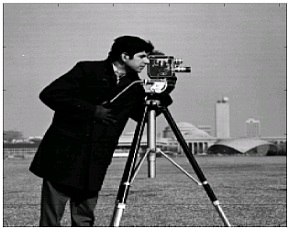
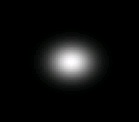
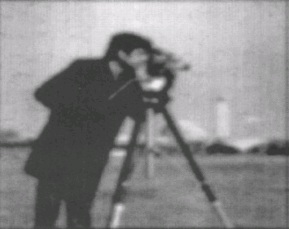
(b)
(a)
Figure 1.2.
Once we apply the PSF to the original image, we receive our blurred image that is shown in
Figure 1.3:
Figure 1.3.
Frequency Domain Analysis
Example 1.1 looks at the original images in its typical form; however, it is often useful to look at our images and PSF in the frequency domain. In Figure 1.4, we take another look at the image blurring example above and look at how the images and results would appear in the frequency
domain if we applied the fourier transforms.
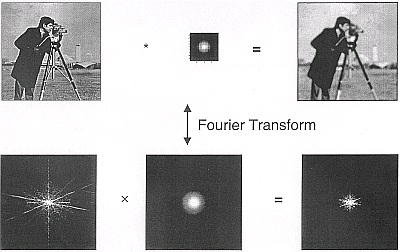
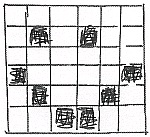

Figure 1.4.
1.2. Digital Image Processing Basics*
Digital Image Processing
A sampled image gives us our usual 2D array of pixels f[ m, n] (Figure 1.5): Figure 1.5.
We illustrate a "pixelized" smiley face.
We can filter f[ m, n] by applying a 2D discrete-space convolution as shown below (where h[ m, n] is our PSF):
()
Example 1.2. Sampled Image
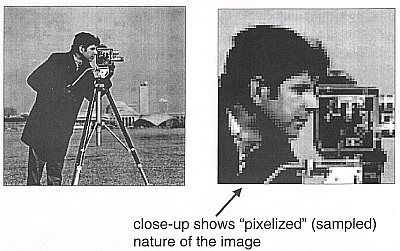

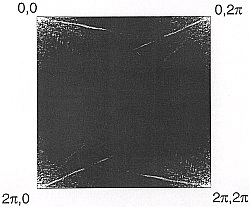
Figure 1.6.
Illustrate the "pixelized" nature of all digital images.
We also have discrete-space FTS:
()
where F[ u, v] is analogous to DTFT in 1D.
"Convolution in Time" is the same as "Multiplication in Frequency"
()
g[ m, n]= h[ m, n]* f[ m, n]
which, as stated above, is the same as:
()
G[ u, v]= H[ u, v] F[ u, v]
Example 1.3. Magnitude of FT of Cameraman Image
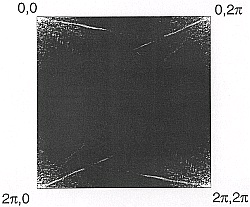
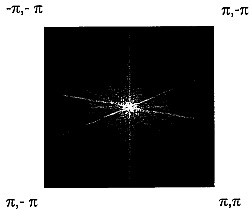



Figure 1.7.
To get a better image, we can use the fftshift command in Matlab to center the Fourier
Transform. The resulting image is shown in Figure 1.8:
Figure 1.8.
1.3. 2D DFT*
2D DFT
To perform image restoration (and many other useful image processing algorithms) in a computer,
we need a Fourier Transform (FT) that is discrete and two-dimensional.
()
for k={0, …, N−1} and l={0, …, N−1} .
()
()
where the above equation (Equation) has finite support for an N x N image.

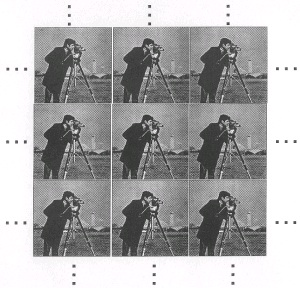



Inverse 2D DFT
As with our regular fourier transforms, the 2D DFT also has an inverse transform that allows us to
reconstruct an image as a weighted combination of complex sinusoidal basis functions.
()
Example 1.4. Periodic Extensions
Figure 1.9.
Illustrate the periodic extension of images.
2D DFT and Convolution
The regular 2D convolution equation is
()
Example 1.5.
Below we go through the steps of convolving two two-dimensional arrays. You can think of f
as r

























